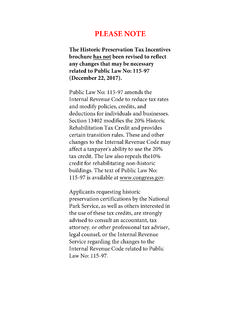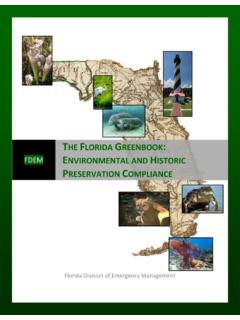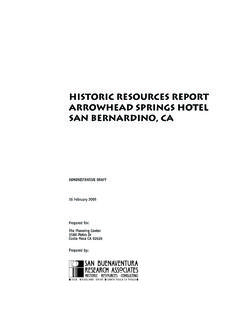Transcription of DESIGN GUIDELINES FOR NEW CONSTRUCTION IN …
1 SENSE OF PLACE: DESIGN GUIDELINES FORNEW CONSTRUCTION INHISTORIC DISTRICTS A Publication of the Preservation Alliance for Greater Philadelphia2007 Supported by a grant from the William Penn FoundationAcknowledgementsThis publication was made possible by a grant from the William Penn Foundation. The William Penn Foundation,founded in 1945 by Otto and Phoebe Haas, is dedicated to improving the quality of life in the Greater Philadelphiaregion through efforts that foster rich cultural expression, strengthen children s futures, and deepen connections tonature and community. The Preservation Alliance is grateful for the foundation s publication has benefited from the work on many other organizations and the contributions of many individu-als. The Preservation Alliance is grateful to all who have contributed.
2 A full list of credits is included at the end of thepublication. The Preservation Alliance is especially grateful to the National Trust for historic Preservation and StevenW. Semes for permission to reprint Mr. Semes s article. We are also grateful for the advice and guidance of TimKerner, Terra Studio, and for his assistance with research, analysis of case studies and development of the conceptspresented in this report. This publication was made possible by a grant from the William Penn Foundation. The William Penn Foundation,founded in 1945 by Otto and Phoebe Haas, is dedicated to improving the quality of life in the Greater Philadelphiaregion through efforts that foster rich cultural expression, strengthen children s futures, and deepen connections tonature and community.
3 The Preservation Alliance is grateful for the foundation s opinions expressed in this publication are solely those of the Preservation Alliance for Greater Philadelphia. Casestudies of specific buildings have been used to test and illustrate DESIGN GUIDELINES for new CONSTRUCTION in historic dis-tricts. Comments about the compatibility of some buildings with their historic settings is not intended to be criticalof the property owners, developers or OF PLACE: DESIGN GUIDELINES FOR NEW CONSTRUCTION IN historic DISTRICTS Introduction1 Purpose of the Report2 Organization of the Report2 Part One: Differientated and Compatiable :Four Strategies for Additions to historic Settings 4 Part Two: DESIGN GUIDELINES of Other Organizations12 Part Three: GUIDELINES Suggested by historic Districts18 Part Four:Preliminary Guidelines22 Part Five:Summary of Case Studies24 Part Six:Recommended Approach and DESIGN GUIDELINES for New CONSTRUCTION in historic Districts30 Appendix.
4 Case Studies32 Preservation Alliance for Greater Philadelphia 2007A Publication of the Preservation Alliance for Greater Philadelphia1 Sense of Place: DESIGN GUIDELINES for New CONSTRUCTION in historic DistrictsIntroductionThe passage of legislation by City Council in 1997 providing a ten-year tax abatement forconversion of older buildings to residential use and the subsequent passage of a ten-year taxabatement program for new CONSTRUCTION in 2000 contributed to a dramatic increase in residen-tial development in Center City and adjacent neighborhoods. The tax abatement program forconversion of existing buildings resulted in theadaptive use of many historic to the Center City district , 75% of allresidential units produced or proposed in theperiod from 1999 to 2005 were created throughthe conversion of existing buildings.
5 Many ofwhich were listed on the Philadelphia Register ofHistoric Places, listed individually on theNational Register of historic Places or located inNational Register historic Districts. The extension of the tax abetment programto new CONSTRUCTION , coupled with the stronginterest in condominium development, alsoproved to be a strong incentive for residentialdevelopment. Because almost all of Center Cityand some adjacent neighborhoods are local orNational Register historic Districts many newresidential projects invariably, have been locatedin historic districts. Many of these projects have been of concern to community organizationsand preservation organizations. Larger projects have often been significantly different in height,architectural style and materials from their historic context.
6 Smaller projects, such as single-fami-ly houses and row house developments, have introduced features not found in historic districtssuch as first floor parking garages. The Preservation Alliance s mission is to preserve and protect Philadelphia s historic build-ings and communities that is, to preserve and protect sections of the city that have been desig-nated as local or National Register historic Districts or that have a consistent or distinctivephysical character or history. The Alliance has found that much of its advocacy work during thepast five years has focused on evaluating the impact of new CONSTRUCTION on historic areas andtrying to mitigate that impact. The Alliance s comments on these projects have expressed a pref-erence for designs that reflect and relate to the context in which the new development is locatedmore than for designs whose architectural style and character tries to be distinctly different andin contrast to the historic setting.
7 This does not mean that the Alliance opposes contemporarydesign. Our support of such projects as the Western Union Building, 10 Rittenhouse, the addi-tion to the Perelman Building and the addition to the National Products building all indicatethat the Alliance has a high degree of respect for contemporary DESIGN when there is a seriousattempt to relate a new building to its historic context. As the Alliance has examined new CONSTRUCTION projects over the past five years we havetried to determine what factors most result in new designs that harmonize with their historic set-tings. This has been an empirical process: we have examined proposals for new buildings andCenter City and adjacent historic districtsvisited completed buildings to observe how and why they fit well or poorly into their historiccontext.
8 We have also drawn guidance from a variety of other sources: from the section of theSecretary of the Interior s Standardsthat discusses new additions and new buildings in districts(Standard 9), from the Philadelphia Historical Commission s guides for property owners in his-toric districts, from DESIGN GUIDELINES established by community organizations in historic neigh-borhoods and other advocacy organizations, and by careful observation of the characteristics ofPhiladelphia s historic districts themselves. As part of the process of preparing this publication,we also convened a focus group of professionals in the preservation and architecture fields toexamine a series of recent buildings and evaluate their appropriateness for their historic setting. PURPOSE OF THE PUBLICATIONThis publication describes the results of the process outlined above and the DESIGN criteriaand approach that the Alliance has concluded is likely to produce new designs that are mostsympathetic to historic districts.
9 The publication has three objectives: first,it is intended to guide the Alliance s evaluation of new CONSTRUCTION projects andto assist community organizations and regulatory agencies in their review of proposalsfor new CONSTRUCTION in historic districts; second,it is intended to assist architects and developers planning and designing projects in historic contexts; and third,it is intended to stimulate debate about the DESIGN of new buildings in historicdistricts. It is a work in progress that the Alliance expects to refine as we continue toreview proposals for new CONSTRUCTION in historic districts. The DESIGN criteria and the approach recommended here are specifically intend for historicareas those districts listed or pending listing on the Philadelphia Register and the NationalRegister, as well as neighborhoods of the city that are not historic districts but have a highdegree of continuity in their physical environment.
10 The DESIGN criteria are notintended to applyto individual buildings in neighborhoods or settings where there is no historic context to relateto or to neighborhoods with no consistent physical character. However, since many neighbor-hoods throughout the city have a consistent physical character, the GUIDELINES and approachdescribed here may be applicable to many neighborhoods. ORGANIZATION OF THE PUBLICATIONThe Alliance recognizes that our preference for buildings that fit in more than for thosethat stand out may appear to be a pre-determined point of view or an expression of personaltaste. We recognize that there are other points of view and have tried to take those into consider-ation in developing our approach. We have been aided particularly Steven W.





